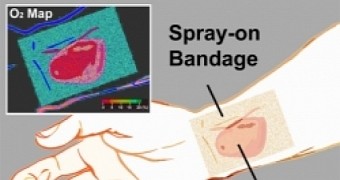Injuries are not fun, and soldiers get into a lot of scraps even when there isn't any war going on. That's why there is a whole division of military medics in the army/navy/airforce. There's always something new that can help though.
On that note, there is always an improvement that is just waiting to be applied to methods and tools that have been in use for centuries.
Bandages are one of the oldest forms of healing techniques, since they keep flesh/bones in place, stem blood flow and generally allow the body to recuperate faster.
A team of researchers has created a totally new type of bandage, one that doesn't actually qualify as a bandage until it is actually applied on the injured area. The rest of the time, it takes the form of a spray.
The SMART Bandage
SMART Bandage is just the abbreviation for Sensing, Monitoring And Release of Therapeutics Bandage, which we can all agree is too much of a mouthful.
Made for the treatment of people with acute or chronic wounds, the bandage not only helps stem blood flow and the like, but it directly and noninvasively measures tissue oxygenation.
After applying it, the bandage can monitor patients with risk of restricted blood supply (ischemia), as well as monitor skin grafts and skin flaps after they have been surgically applied.
Moreover, the SMART Bandage can help determine the depth of a burn, allowing surgeons to better remove dead or damaged tissue from the body.
How the SMART bandage works
It all boils down to what it's made of. One part is a bright sensor molecule with phosphorescence that glows stronger and longer the less oxygen is available. A green oxygen-insensitive reference dye supplements the phosphorescence, leading to the oxygenation level being indicated by a green-to-red color map.
The bandage also boasts a readout device, basically a camera that provides bursts of light to trigger the phosphors in the bandage, and then to record the phosphor's emissions.
As for how the bandage is applied, you essentially paint it on the skin surface. Initially, it's a viscous liquid, but once it dries (about a minute), it becomes a solid thin film. After that, a second, transparent barrier layer is placed over it for protection, as well as to reduce the oxygen exchange rate between the bandage and room air, otherwise the bandage wouldn't react to the oxygen in the skin, but the one in the air, rendering it useless.

 14 DAY TRIAL //
14 DAY TRIAL //